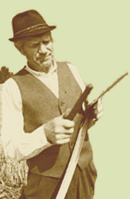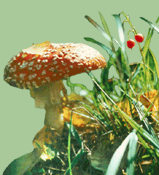Carl Linné 300
A great Swede with a gentle plant
Hans Trass looks at the input of a great, diverse scientist into the science of botany, especially plant systematics. But there is more. Linné has been named the King of Botany he was the one who created the systematics of living nature and the binary basis for naming organisms. Due to his studies and his students, the amount of plants known to science grew from 7300 in 1753 to about 100 000 in the beginning of the 19th century. He also had his own theories about creationism. He was a scientist of many interests: he was also interested in other forms of nature, trying to classify everything. Besides botany, his input is essential in the sciences of plant geography, geobotany and ecology.
Estonian Nature enquires
Erast Parmasto writes about Linnés influence on contemporary science.
Tiit Merenäkk explains the essence of the paper called Green Häädemeeste.
Twinflower Linnés favourite plant
Aino Kalda likes the gentle posture of the favourite plant of Carl Linné and many others. This gentle flower, inhabitant of northern boreal forests, accompanies Linné on paintings and bears his name: Linnaea borealis. The twinflower is not rare in Estonia, but only grows in certain places. The article describes the biology and distribution patterns of the species.
Uppsala Linnés town
Ülo Väli has spent a large part of his life in Uppsala, just like Linné did. Linné studied botany in the University of Uppsala and eventually became the most nominent professor and the rector of the university. Uppsala, with nice living environments is the center of life sciences even today. The people of Uppsala are very keen on biking in the town, as well taking a hike in Stadsskogen, the large City Forest.
A glance into the home of Carl Linné
Toomas Frey takes a peek into the houses of the great botanist in the Botanical Gardens of the Uppsala University and in Hammarby. Linnés house in Uppsala was situated right next to the botanical collection and is now functioning as Linnés house museum. The Linné family (wife and 4 children) also had a summer house in Hammarby near Uppsala. Linné had a museum built in Hammarby, to maintain his collections, which is now also furnished as a house museum.
Carl Linnés connections with the Baltic States
Linda Kongo estimates the influence of Linnés students at the development of natural sciences in Estonia and Livland. She also introduces a letter by Linné that is stored in Tartu. There are at least 6 Baltic-born students who are known to have attended Linnés courses. The author pays special attention to J.B. Fischer, the best-known Linnés student from the Baltics.
Which animal group is the most species-rich?
Marko Prous demonstrates, using the methods of todays systematics, which of the existing animal groups can be considered as the most species-rich. There are different ways of counting the species, but on the broad scale it can be said that beetles are the most species-rich animal group.
European rarities in Estonia: Scarce Fritillary and Marsh Fritillary
Mati Martin introduces two butterfly species with a mosaic distribution in Europe. The species are both common in Estonia. Both species have many subspecies. The colourful photos and distribution maps help to get insight into the biology and status quo of the bright-coloured butterfly species.
Interview: Estonian weather is no surprise for the climate scientists
Katre Palo has interviewed Jaak Jaagus, a climate researcher.
Hiking trail: A boardwalk hike in the Teringi mire
Katre Palo suggests taking a hike in diverse, but small mire in the Viljandi County, near the border of Latvia. The trail is situated in the 321 ha-large Teringi landscape protection area, the majority of which is occupied by mire landscape. The 4.5 km-long boardwalk features several sights of interest and makes one acquainted with the mire and Alatsi Lake. The nature is real wilderness with only slight traces of human activity.
Spring break in nature with my camera
Rene Viskar recalls his spring break that he spent in Matsalu, with his camera, some elks and white-tailed eagles.
Practical tips: The best help for a nature lover is the Internet
Kerli Nõu shares recommendations of how to spend the least amount of effort on finding and getting an interesting product from the worlds largest store. You can buy anything from the Internet; the author describes some of the most exiting products that can be of interest for naturalists and gives several hints for on-line shopping.
Why the road-side pine trees become brown?
Tõnu Ploompuus reflection on an article in the April issue of Eesti Loodus. The author claims that the only reason for such brownness is the salt used for keeping the snow off the roads.
The BSR eagle over the Baltic Sea
Toomas Jüriado describes the nature education project of the Baltic Sea countries and hopes that the project will continue. The BSR stands for Baltic Sea Region and the Interreg III B-financed project incorporates about 50 different institutions from all around the Baltic Sea.
Smooth Snake in Setumaa?
Nikolai Laanetu calls to open ones eyes when in Setumaa: most likely the home for our third reptile species. There are several hints that allow us to presume the presence of Smooth Snake in this area: the species description by different people as well as the local language, which has a special name for the snake.
| 

![[IN ENGLISH]](images/gb.gif)





